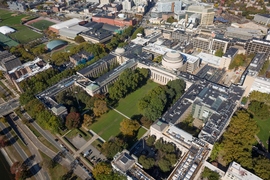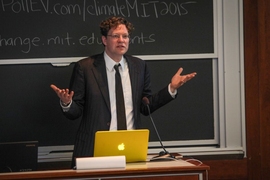With nations preparing for the global climate talks in Paris under the UN Framework on Climate Change (COP21), an MIT delegation traveled to France on Oct. 27 to meet with European government, industry, and academic representatives on the topic of climate change. MIT representatives, who met with their European counterparts at the residence of the U.S. Ambassador to France in Paris, included MIT Corporation Chair Robert Millard, Vice President for Research Maria Zuber, MIT Energy Initiative (MITEI) Director Robert Armstrong, and professors Angela Belcher and Donald Sadoway.
In a gathering convened by U.S. Ambassador to France Jane Hartley, with CEOs and CTOs from French industry, leaders of government agencies, and heads of French universities, the MIT participants discussed climate efforts to date, covered the MIT climate plan, and solidified a framework for engaging with these international partners on shared goals for addressing climate change.
Discussing climate challenges
The meeting was part of a larger initiative in advance of the climate talks for Ambassador Hartley — on behalf of U.S. President Barack Obama — to gather a number of different perspectives on how academia, government, and industry can address climate challenges. “It was an amazing, mutually beneficial gathering,” Zuber reflected. “All parties discussed efforts thus far to combat climate change, and together we brainstormed ideas to work together to amplify our efforts in the future.”
At the meeting, Millard set the tone for the gathering by discussing MIT’s core value of service to the nation and the world, while Ambassador Hartley emphasized the the high priority of climate action in President Obama’s agenda. Zuber and Armstrong briefed French officials and embassy representatives on the MIT climate plan, the result of a more than a year of involvement and intense discussion across MIT. “The MIT community as a whole made significant contributions to this plan,” Zuber said.
Armstrong highlighted a key action item from the climate plan: the creation of Low-Carbon Energy Centers, interdisciplinary centers to advance technology in key areas critical to fighting climate change. The first five of these centers will focus on solar power; energy storage; carbon capture, use, and sequestration; advanced materials; and nuclear energy. The ultimate goal of these centers, above and beyond widening the scope of scientific research, is to put the global energy system on a path to rapid decarbonization within a generation.
MIT’s collective sense of urgency in tackling the issue of climate change was something that Zuber said “resonated very strongly” with all of the leaders at the embassy presentation. “Climate change is not only a global problem, but also a personal issue,” she said. “Working within communities to come up with solutions made sense to all in attendance.”
Global partnerships
The discussion around the MIT climate plan and COP21 also highlighted research results. Several of the breakthroughs MIT has had over the years in developing low-carbon energy technologies were facilitated by several of the companies at the meetings.
At the embassy were representatives from Total, EDF, and Energie, all of which have partnered with MIT to support energy and environment research towards mitigating climate change.
Donald Sadoway, a professor of materials science and engineering, has worked with French energy company Total on research that led to a new energy storage company. Sadoway and his team at MIT invented a liquid metal battery, an idea that started as a Seed Fund project through the MIT Deshpande Center, before MITEI was founded. As they were amping up research in order to determine whether or not the battery could be commercialized, “Total stepped forward and did very significant funding on this research project with Don’s team,” MITEI director Armstrong said. “This research project was integral in Don later going on to receive an ARPA-E grant for continued work on the liquid-metal battery.” Advanced Research Projects Agency-Energy (ARPA-E) grants are awarded by the U.S. Department of Energy to high-risk, early-stage projects that show immense promise.
The result is a company, Ambri, which today is streamlining a molten salt/liquid metal battery that could be the future of energy storage. Along the way, Sadoway and his team, which includes Ambri CTO and MIT alum David Bradwell, have garnered support from such diverse sources as Khosla Ventures and Bill Gates, in addition to their early and continued support from Total.
Professor Angela Belcher of the departments of Biological Engineering and Materials Science and Engineering, spoke about energy research, as well. In her lab, researchers are using bioengineering and materials science to create new materials with varied energy applications such as solar cells and batteries. Some of Belcher’s latest research involves genetically engineering viruses to transport energy — a hybrid of quantum physics and biology that Belcher and her team are using to design more efficient solar cells based on natural processes such as photosynthesis.
Armstrong also highlighted MIT’s Utility of the Future project, of which EDF and Energie are members. Utility of the Future is a multi-year comprehensive study on the future of the electric power sector, given the ongoing development of transformative technologies and the changing global energy landscape. This type of “collective thinking about where the energy system is going,” as Armstrong puts it, “is crucial if we are going to commercialize and incorporate new low-carbon breakthroughs.”
Not a hope, a strategy
One of the major questions attendees at the meeting touched upon was that of the role of the developed world versus that of the developing world in mitigating climate change. “These two constituencies are critical to finding a solution,” Zuber said. “Developing nations need energy options that are both sustainable and cost-effective.” The developed world can help developing nations adopt and scale those low-carbon energy alternatives, as the MIT Tata Center for Technology and Design is doing as part of its work with India, and as the MITEI Low-Carbon Energy Centers will do.
Following the COP21 negotiations, as nations work towards meeting their intended nationally determined contributions, it is all the more important to continue holding meetings between innovation hubs like MIT and world business and political leaders. In the eyes of Zuber and Armstrong, gatherings like the October meeting Ambassador Hartley convened not only strengthen international connections, but also serve to accelerate innovation.
Zuber plans for MIT to continue playing a role in these global meetings of the minds long after the climate summit is over, with action-oriented agendas. “At MIT,” she says, “we are driven by a shared sense of urgency. As a result, our climate plan is a strategy, not a hope. There’s a whole lot of work and intense implementation ahead, and we’re committed to doing the follow-up.”










